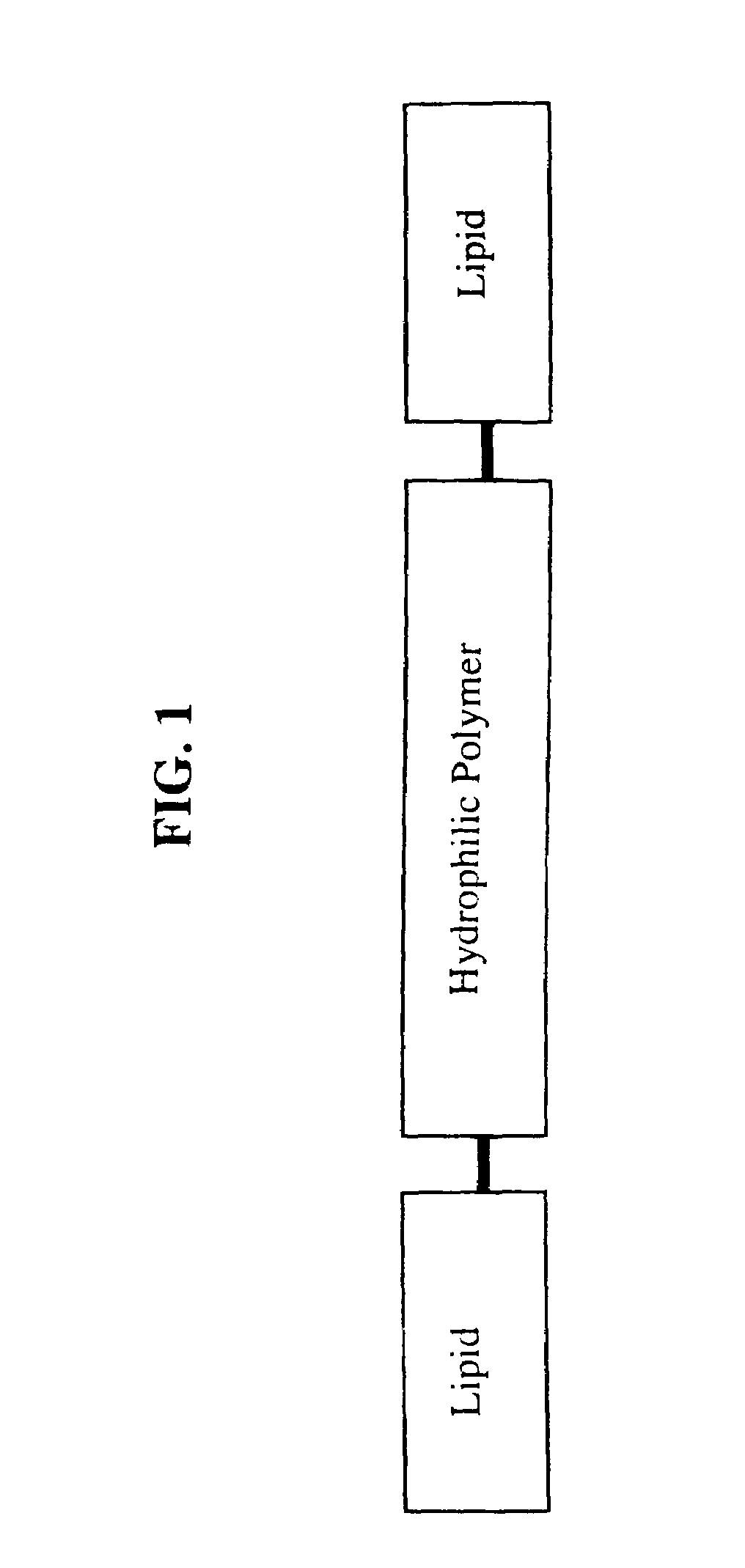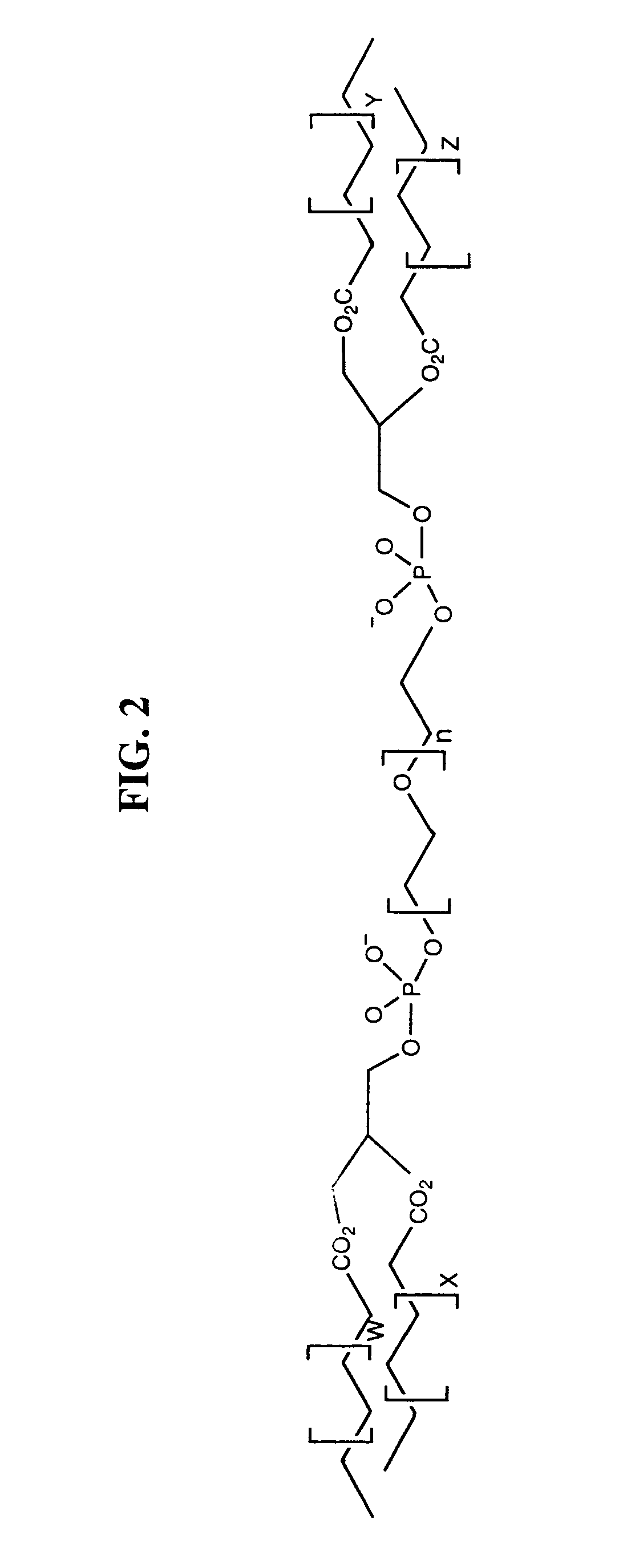Amphiphilic materials and liposome formulations thereof
a technology of amphiphilic materials and liposomes, which is applied in the field of amphiphilic materials and liposome formulations thereof, can solve the problems of insufficient yield, inability to yield sufficient beneficial, and inability to develop reasonably active conjugates for every enzyme contemplated in vivo
- Summary
- Abstract
- Description
- Claims
- Application Information
AI Technical Summary
Benefits of technology
Problems solved by technology
Method used
Image
Examples
example 1
PREPARATION OF α,ω-BIS(1,2-DISTEAROYL-SN-GLCERO-3-PHOSPHO)-POLYETHYLENE-GLYCOL(3350) [DSPA-PEG(3350)-DSPA]
[0208]Polyethyleneglycol, mol wt. 3350 (3.3500 g, 1.0 mmole) and 1,2-distearoyl-sn-glycero-3-phosphoric acid (distearoylphosphatidic acid, DSPA) (1.8149 g, 2.25 mmole) were dried under vacuum over P2O5, dissolved in anhydrous pyridine (15 ml) and treated with 2,4,6-triisopropyl-benzenesulphonyl chloride (TPSC1) (1.5143 g, 5.0 mmole) at R.T. for 30 min. followed by reaction at 45° C. for 2.5 hr. The procedure is adapted from the general method for phosphatidylation of alcohols (Aneja et al., 1970). The reaction mixture was cooled to 0-5° C. and treated with water (0.2 ml) for 18 hr. and then evaporated to dryness under reduced pressure at 37° C. The residue was applied to a column of flash chromatography silica packed in CHCl3—CH3OH—NH4OH (95:5:0.1), and eluted with the same solvent mixtures containing increasing proportions of CH3OH and NH4OH. Pure title compound was eluted with...
example 2
PREPARATION OF α,ω-BIS(1,2-DIOLEOYL-SN-GLYCERO-3-PHOSPHO)-POLYETHYLENE-GLYCOL(3350) [DOPA-PEG(3350)-DOPA]
[0211]This compound was prepared from polyethyleneglycol, mol wt. 3350 (0.3350 g, 0.1 mmole) and 1,2-dioleoyl-sn-glycero-3-phosphoric acid (dioleoylphosphatidic acid, DOPA) (0.4431 g, 0.6 mmole), and characterized, exactly as described in Example 1 for DSPA-PEG(3350)-DSPA. The compound was obtained as a colorless glass at R.T., yield 0.3428 g (72.8%). The product was >99% pure by TLC on silicagel G eluted with CHCl3—CH3OH—NH4OH (85:15:2) (Rf 0.6), and HPLC on silicagel eluted with CHCl3—CH3OH—NH4OH (89:10:1). The 1H-NMR (300 MHz, CDCl3) also showed δ ppm 5.34 (m, 8H, 4 HC═CH).
example 3
PREPARATION OF α,ω-BIS(1,2-DIOLEOYL-SN-GLYCERO-3-PHOSPHO)-POLYETHYLENE-GLYCOL(2000) [DOPA-PEG(2000)-DOPA]
[0212]This compound was prepared from polyethyleneglycol, mol wt. 2000 (0.2000 g, 0.1 mmole) and 1,2-dioleoyl-sn-glycero-3-phosphoric acid (dioleoylphosphatidic acid, DOPA) (0.4332 g, 0.6 mmole), and characterized, exactly as described in Example 1 for DSPA-PEG(3350)-DSPA. The compound was obtained as a colorless glass at R.T. yield 0.2354 g (67.9%). The product was >99% pure by TLC on silicagel G eluted with CHCl3—CH3OH—NH4OH (85:15:2) (Rf 0.7) and HPLC on silicagel eluted with CHCl3—CH3OH—NH4OH (89:10:1). MALDI-TOF MS 3344 (M+); the 1H-NMR (300 MHz, CDCl3) also showed δ ppm 5.32 (m, 8H, 4 HC═CH).
PUM
| Property | Measurement | Unit |
|---|---|---|
| Fraction | aaaaa | aaaaa |
| Fraction | aaaaa | aaaaa |
| Fraction | aaaaa | aaaaa |
Abstract
Description
Claims
Application Information
 Login to View More
Login to View More - R&D
- Intellectual Property
- Life Sciences
- Materials
- Tech Scout
- Unparalleled Data Quality
- Higher Quality Content
- 60% Fewer Hallucinations
Browse by: Latest US Patents, China's latest patents, Technical Efficacy Thesaurus, Application Domain, Technology Topic, Popular Technical Reports.
© 2025 PatSnap. All rights reserved.Legal|Privacy policy|Modern Slavery Act Transparency Statement|Sitemap|About US| Contact US: help@patsnap.com



